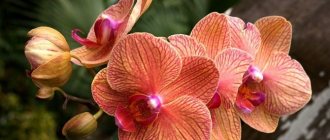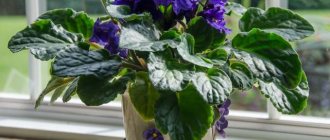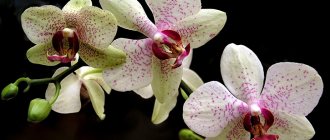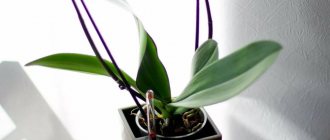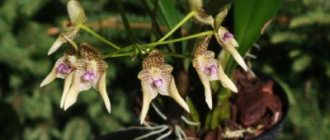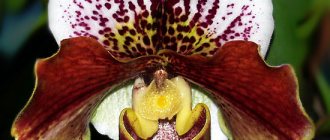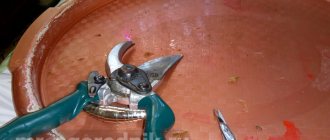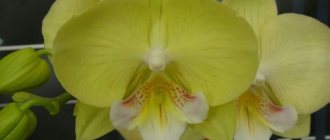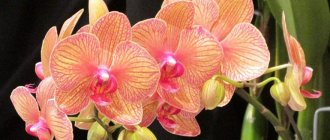The lifespan of orchids in the wild can reach hundreds of years. And those hybrids and varieties that were bred by breeders for breeding in greenhouses and apartments live much shorter. Their life expectancy depends on the conditions of their detention. Part of the care process is rejuvenation and replanting of plants. If you know how to rejuvenate an orchid correctly and on time, you can prolong its existence.
Flowering and life cycles of orchids - how they differ
The life period and flowering time of a plant are different concepts. Flowering begins at the moment the arrow appears and the buds form and ends after the flowers drop. The lifespan is counted from planting until the plant dies.
How long does it bloom?
The flowering period is determined by the conditions of keeping the orchid and its condition. As a rule, it can be long - from 2 to 6 months.
How many years has he lived at home?
The lifespan of tropical flowers depends on the variety. So, phalaenopsis is considered to be long-lived. With proper care, the plant can reach 7-10 years of age.
How to find out the age of a crop and what affects its duration?
By counting the number of leaves in the orchid family, it is impossible to determine the age. Age can be judged by appearance. If the plant has several cuts of old branches and a long trunk, then the plant is clearly not young. If phalaenopsis is without flowers and buds, this indicates that it is still very young.
The lifespan of an orchid is certainly influenced by the conditions of its maintenance. An important factor is the condition of the flower.
Before purchasing an orchid, check its quality. How to check the health of a flower:
- Visual inspection. The leaves should be strong, the aerial roots should be firm and green or reddish-brown in color.
- The plant in the pot sits firmly and does not wobble. Otherwise, the flower will not take root.
- Touch the substrate - it should be wet and loose.
- You should not buy a flower if it has a coating in the form of lime deposits on the leaves or on the container itself.
Buy an orchid that has medium-sized unopened buds.
If the substrate is overgrown with moss, then you cannot buy such an orchid.
The quality of water directly affects the lifespan of your beauty. Water should have a minimum amount of lime salts, which cause hardness. The pH level should be 5-6.5.
Do not water the orchid with tap water. Use filtered, rain, melt or boiled water.
The orchid is a strong plant. The key to a long life of phalaenopsis is the prevention of diseases and pests:
- Carry out regular inspections, wipe the leaves from dust, remove old roots and yellowed leaves as early as possible.
- Use clean tools for pruning.
- Pay special attention to young, new, recently transplanted plants.
This way you can prevent the premature death of the plant.
Phalaenopsis is one of the varieties of orchids that are popular among gardeners due to the beauty of their flowers. How this plant reproduces, and how it differs from orchids - read in our materials.
What materials and tools need to be prepared
The most important thing is to choose a convenient cutting tool. As a rule, garden knives are used for cutting. But the trunk of the plant is quite hard, it is not always possible to cut it with a knife, so you can use pruning shears.
To restore the plant, you need:
- alcohol solution for cleaning instruments;
- brilliant green or cinnamon powder to disinfect cuts;
- a clean piece of soft fabric;
- pot with holes.
Additional landing capacity is needed because the trunk is divided into two parts. The old flower receives new life and at the same time reproduction occurs.
Experienced gardeners advise rejuvenation in the spring. At this time, with increasing daylight hours, the activity of biochemical processes inside the plant is maximum. The likelihood that it will take root well is high.
Care
Both young and adult plants require constant attention and care. A young orchid requires more frequent watering. Otherwise, the growing rules are similar.
During the flowering period, the orchid absorbs more nutrients, so it needs to be watered and fertilized more often. A flowering plant requires more light and heat. During the dormant period, the orchid increases its green mass. You should also not forget about watering at this time. It is important to provide the necessary humidity in the room.
Phalaenopsis orchid is a perennial plant. It is very popular among flower growers. And this is well deserved. The plant is very unpretentious, incredibly beautiful and original. With proper care, the orchid will delight its owners for many years.
How to divide an orchid
The technique for dividing a flower is as follows:
- The instrument is treated with an alcohol solution.
- The orchid is carefully removed from the planting container.
- The roots are cleared of soil and inspected.
- Dry roots are removed.
- Select an area on the trunk where to make the cut.
- The flower is quickly cut into two parts.
- The sections are treated with cinnamon powder or brilliant green.
- Within 24 hours, both parts are dried so that the sections begin to tighten and the risk of infection decreases.
Important! The cut site is the point above which aerial roots grow from the leaf axils.
So the orchid is divided into two parts. The young one has leaf blades and aerial roots, the old one has an existing root system; it may not have leaves.
Reader Questions
How to trim a rotten neck?
Sometimes, if the rules of care are not followed, the root collar of the phalaenopsis begins to rot. This process develops very quickly and the likelihood of losing a flower increases several times.
There is no need to despair, the orchid can be saved. To do this, you need to cut off the part with rot , this must be done with a sharp knife to the living tissue.
It is important to ensure that there are no putrefactive inclusions left on the trunk, otherwise the plant will get sick again.
Afterwards, processing of the sections is required . It is forbidden to spray phalaenopsis until the cut is completely healed , otherwise the rot will quickly return and destroy the flower.
What to do with a wilted bud?
Withered buds look unsightly, many people rush to cut them off, but this is not always true. This type can be acquired by the peduncle of a plant that lacks moisture.
To begin with, you can try to save the flowering, for this you should give the flower a warm shower or water it more often and a little more abundantly. If after a couple of procedures the elasticity has not returned, then it will have to be removed.
Buds may wilt due to lack of moisture.
But here, too, not everything is so simple; pruning should be done 3-5 cm below the dried area. With proper care, very soon the plant will again delight you with abundant flowering.
How to care for re-rooted plants
During the first week after re-rooting, the pots are kept in a warm, ventilated room. For additional illumination, a phytolamp is used. Then, when leaving, they are guided by the following rules:
- Watering. Until both parts are completely rooted, they are watered with a watering can, in moderation. The soil should dry completely between waterings.
- Spraying. This procedure is mandatory, especially if the air humidity is low. Warm water is used.
- Ventilation. Plants should be protected from drafts. But the room must be well ventilated to prevent the development of fungal diseases and rot.
Attention! You can evaluate how successfully you managed to rejuvenate and re-root in a month. The upper part by this time demonstrates active growth of the root system. New roots appear on the bottom, and trunk growth is observed.
Age determination
The age of Phalaenopsis is difficult to determine accurately. This cannot be done by counting the number of leaves.
It is known that a plant that has reached five years old produces children. Another way to determine age is to count leaves and bulbs. But this is relative.
The owner must be sure that the plant is completely healthy and has never been replanted.
Root rot
Any plant with roots affected by rot will definitely not bloom. The development of rot is most often caused by regular waterlogging of the soil in combination with low indoor temperatures. The substrate in the pot becomes covered with a layer of mold and gives off an unpleasant odor.
To assess the extent of the problem, you need to remove the plant from the pot and clean the roots from the soil. Rotted tissues are black or dark brown and slimy to the touch.
They are cut off with a sharp, disinfected knife, the “wounds” are washed with a bright pink solution of any fungicide or potassium permanganate (potassium permanganate) and sprinkled with sifted wood ash, powdered activated carbon or chalk.
1.5-2 hours after the “operation” the plant is transplanted into a fresh substrate and a new pot. You can’t expect it to bloom quickly; the plant needs time to recover.
Substrate of poor quality
For cultivation, a substrate is used, consisting mainly of pieces of pine bark. Other ingredients are peat chips, sand, pieces of charcoal, chopped dry sphagnum moss, fine expanded clay, even polystyrene foam.
Ordinary soil for indoor plants is not suitable for orchids due to its high moisture capacity and “oversaturation” with minerals. In such conditions, root rot develops quickly and the plant will not bloom.
To form a peduncle, it must be transplanted into a substrate of suitable quality. During the transplantation process, be sure to inspect the roots and cut out all dead tissue affected by rot.
I recommend watching the video (be sure to watch it to the end), you will learn a lot of new things:
Preparing for surgery
First of all, it is necessary to disinfect the instruments. It is best to heat them over a fire, and then wipe them with a swab with vodka or calendula tincture.
Make a solution of Zircon or Epin, prepare the substrate. This soil contains:
Among the preparations you will need undiluted Maxim summer resident, cinnamon or activated carbon.
The leaves grow, but the peduncle does not appear: reasons
There are many factors leading to the lack of peduncle growth. Let's tell you more about each of them.
Overwatering
Phalaenopsis does not tolerate frequent watering, especially when the upper leaves are released. Usually a peduncle grows along with them. It is also recommended to reduce the frequency of watering during the rest period.
Lack of nutrients
Conventional fertilizers based only on potassium and phosphorus are not suitable for feeding phalaenopsis. For these plants, you need to select special complexes for orchids (they have a low nitrogen content).
In the summer, fertilizing is applied once a month, and in the spring - every two weeks.
Only with such a schedule will the crop receive adequate nutrition. In winter, it is not recommended to fertilize at all: the crop should rest.
Early age
Flowering of phalaenopsis begins no earlier than 1.5 years, it is better if this happens at about 2.5–3 years. Then the plant will become completely stronger and gain strength to bloom flowers. It is generally not recommended to stimulate flowering before 1.5 years, as the orchid will spend all its energy and will not be able to develop further.
Hypothermia
The optimal temperature for the development of phalaenopsis ranges from 18–24 degrees. At lower temperatures, not only will there be no flowering, but there is also a risk of complete death of the plant. In summer, it is recommended to provide the orchid with air heated to 25–28 degrees.
IMPORTANT! For the growth of the peduncle and the appearance of buds, it is necessary to maintain a daily temperature difference (within 4-6 degrees). In the warm season, to ensure a temperature difference, you can take the crop out onto the balcony.
Damaged roots
Damage to the root system affects the development of the entire phalaenopsis. Usually, when the roots are damaged, the leaf blades suffer: they slow down their growth, and the existing ones turn yellow and dry out. You can read more about roots and how to grow them here.
Tight capacity
The rhizome must constantly develop and for this it needs space. The ideal volume of a pot for phalaenopsis is 2–3 cm larger than the diameter of the root system.
Stress
Among the main stressful situations are the following:
- low air temperatures;
- frostbite;
- a sharp change in growth conditions.
Drafts are also stressful for phalaenopsis. It is necessary to ventilate the room regularly, but do not allow a draft wind to occur.
Rest period
It usually begins in the second half of autumn and lasts almost until the end of winter. At this time, reduce the frequency of watering and fertilizing. During the cold period, the orchid completely slows down its growth, but it regains its strength for vegetation and flowering in the spring. Stimulating flowering in winter can only harm the crop.
Diseases
The most common diseases of phalaenopsis are:
- fungal infections;
- rotting of the root system.
Violations of growing conditions, as well as incorrect composition of the soil mixture (especially when applying large amounts of nitrogen fertilizers) lead to diseases.
After transplantation, the growth of the culture stops for some time. This is normal, she needs to get over the disease and adapt to the new place.
Incorrect proximity to other plants
It is recommended to keep Phalaenopsis away from tomatoes and banana trees. Also, in summer, the orchid should not be placed near walnut and apple trees.
Unsuitable substrate
The main characteristic of soil for phalaenopsis is to ensure the circulation of water and air. It is best to purchase a ready-made substrate for orchids. When preparing the soil yourself, be sure to add bark, sphagnum moss, leaf and turf soil, coarse river sand, and expanded clay as drainage.
Incorrect lighting
Both the lack of light and the lack of protection from direct sunlight (especially in summer, during the hottest time of day) are to blame for the lack of flowering. In the first case, the plant cannot develop normally; in the second, it gets sunburned.
For regular flowering, it needs at least 10-12 hours of daylight at any time of the year. The place for the pot is chosen so that diffused light hits the plant from the side. The window sill of an east or west window is also good.
If the plant does not have enough light in winter, it will not form a flower stalk. To ensure the required duration of daylight hours, phytolamps are used.
Methods of resuscitation for diseases
If, as a result of improper location and lighting, the health of the orchid is at risk, the leaves have turned yellow, the roots have atrophied, then, first of all, they arrange a quarantine in the shade, the atrophied roots are cut off, the sections are rubbed with charcoal and watering is organized by immersion. After these procedures, the location of the flower is changed.
- If not properly cared for, fungal diseases occur and lumps form on yellowed leaves. Treatment is carried out with solutions of fungicides and sometimes by removing diseased parts of the flower.
- Bacterial stains. Usually, old leaves are affected, which must be removed and the sections treated with charcoal and bactericidal preparations.
- Root atrophy. The roots have dried out and are no longer able to perform their functions. Phalaenopsis resuscitation, for example, is carried out by division and transplantation. Urgently change care, temperature regime and location. It is also characterized by dried leaves.
- Putrefactive disease (root rots). Improper humidity, watering and temperature conditions can lead to this disease. The flower may look healthy for a long time, although putrefactive lesions are already developing. Resuscitation will help to save the orchid, which is carried out by cutting off the rotten parts and urgent transplantation with mandatory quarantine for a week.
Errors in watering
For normal development, and therefore flowering, of any epiphyte, proper watering is necessary. Orchids react negatively to both “drought” and “swamp” in a pot. When determining the intervals between waterings, they are guided by the condition of the substrate and roots. The first one should dry completely, the second one will develop a silver-gray “patina”.
If there are no other problems, it is enough to adjust the watering. The substrate is moistened by immersion, leaving the pot in a basin of water for 1.5-2 hours. You don’t need to pour too much, just cover the bottom third of the container. Then the excess water must be drained.
Watering is carried out exclusively with warm (40-45°C) water.
